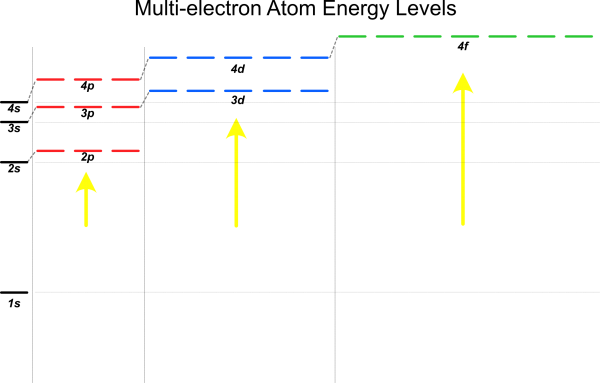Ch7 Lec6
(4/28/20, bes)
Greetings,
- I wanted to post this last lecture well before exam 3 (Friday, May 1st) so that you do not feel too rushed...review these notes as time permits. This is the last lecture for Chapter 7.
Multi-electron Energy Levels
The figure above was presented in yesterday's notes...building upon this...please notice:
- The shift in the energy levels mixes up the order in which the orbitals are filled.
- - the 3d orbitals are now above the 4s orbitals
- - the 4d orbitals are now above the 5s orbitals (not shown in figure)
- - the 5d orbitals are now above the 6s orbitals (not shown in figure)
For boron (B) (as previously discussed), it contains 5 electrons...with 2 electrons per orbital, then the electron configuration is: 1s2 2s2 2p1.
- (Note: in WA i would ask that you enter the answer as, 1s2 2s2 2p1 <-- no superscripts).
For carbon (C) (as previously discussed), it contains 6 electrons...with 2 electrons per orbital, then the electron configuration is: 1s2 2s2 2p2.
- (Note: in WA i would ask that you enter the answer as, 1s2 2s2 2p2 <-- no superscripts).
For neon (Ne), it contains 10 electrons...with 2 electrons per orbital, then the electron configuration is: 1s2 2s2 2p6.
- (Note: in WA i would ask that you enter the answer as, 1s2 2s2 2p6 <-- no superscripts).
For argon (Ar), it contains 18 electrons...with 2 electrons per orbital, then the electron configuration is: 1s2 2s2 2p6 3s2 3p6.
- (Note: in WA i would ask that you enter the answer as, 1s2 2s2 2p6 3s2 3p6 <-- no superscripts).
For calcium (Ca), it contains 20 electrons...with 2 electrons per orbital, then the electron configuration is: 1s2 2s2 2p6 3s2 3p6 4s2.
- (Note: in WA i would ask that you enter the answer as, 1s2 2s2 2p6 3s2 3p6 4s2).
